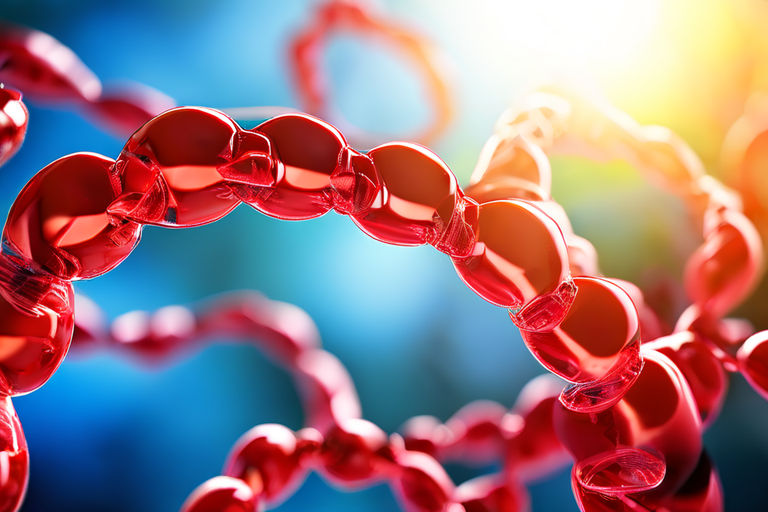Introduction
Understanding the Basics of DNA
DNA, or Deoxyribonucleic Acid, serves as the fundamental blueprint of life. It carries the genetic instructions necessary for the development, functioning, growth, and reproduction of all known living organisms. At its core, DNA holds the key to unlocking the mysteries of heredity and evolution.
Importance of DNA in Living Organisms
The significance of DNA in living organisms cannot be overstated. From the simplest single-celled organisms to complex multicellular beings like humans, DNA plays a central role in orchestrating biological processes. It dictates an organism’s traits, from physical characteristics to biochemical functions, and governs how cells operate and interact within an organism’s body.
Without DNA, life as we know it would not exist. Its intricate structure and ingenious mechanisms allow for the transmission of genetic information from one generation to the next, ensuring the continuity and diversity of life on Earth.
In the following sections, we will delve deeper into the structure, function, and implications of DNA, unraveling the mysteries that make it one of the most fascinating molecules in the natural world.
Structure of DNA
Double Helix: The Iconic Structure
The double helix is the iconic structure of DNA, famously elucidated by James Watson and Francis Crick in 1953. It consists of two long strands twisted around each other in a spiral manner, resembling a twisted ladder or spiral staircase.
Nucleotides: The Building Blocks of DNA
Nucleotides are the basic building blocks of DNA. Each nucleotide consists of three components: a sugar molecule (deoxyribose), a phosphate group, and a nitrogenous base. The four nitrogenous bases present in DNA are adenine (A), thymine (T), cytosine (C), and guanine (G).
Sugar-Phosphate Backbone: Providing Stability
The sugar-phosphate backbone is a repeating pattern of sugar (deoxyribose) and phosphate groups that forms the structural framework of the DNA molecule. This backbone provides stability to the double helix structure, acting as a strong support for the nitrogenous bases.
Hydrogen Bonds: Holding the Helix Together
Hydrogen bonds play a crucial role in holding the two strands of the DNA double helix together. These bonds form between complementary nitrogenous bases on opposite strands: adenine (A) pairs with thymine (T) through two hydrogen bonds, while cytosine (C) pairs with guanine (G) through three hydrogen bonds.
The combination of these structural components – the double helix, nucleotides, sugar-phosphate backbone, and hydrogen bonds – gives DNA its remarkable stability and versatility, allowing it to serve as the carrier of genetic information in all living organisms.
Function of DNA
Encoding Genetic Information
DNA serves as the repository of genetic information in living organisms. It contains the instructions necessary for the development, functioning, and regulation of all cellular processes. The sequence of nucleotides in DNA encodes the genetic code, which determines the sequence of amino acids in proteins and ultimately governs the traits and characteristics of an organism.
Genes: Blueprint of Life
Genes are specific sequences of DNA that code for functional proteins or RNA molecules. They serve as the fundamental units of heredity, carrying the genetic information passed from parents to offspring. Genes play a crucial role in determining an organism’s traits, such as eye color, height, and susceptibility to diseases.
Protein Synthesis: The Central Dogma of Molecular Biology
Protein synthesis is the process by which the genetic information encoded in DNA is used to produce proteins. It involves two main steps: transcription, where the DNA sequence is copied into a complementary RNA molecule, and translation, where the RNA molecule is used as a template to assemble amino acids into a protein. This process, often referred to as the central dogma of molecular biology, is essential for the functioning and regulation of cells.
Regulatory Elements: Controlling Gene Expression
Regulatory elements are sequences of DNA that control the expression of genes. They can either enhance or inhibit the transcription of nearby genes, thereby regulating the production of proteins. Regulatory elements play a crucial role in determining when and where genes are expressed, allowing organisms to respond to internal and external stimuli and adapt to changing environments.
Together, these functions of DNA – encoding genetic information, genes as the blueprint of life, protein synthesis as the central dogma of molecular biology, and regulatory elements controlling gene expression – form the basis of life’s complexity and diversity. They orchestrate the intricate processes that enable organisms to grow, develop, and thrive in their environments.
Function of DNA
Encoding Genetic Information
DNA serves as the repository of genetic information in living organisms. It contains the instructions necessary for the development, functioning, and regulation of all cellular processes. The sequence of nucleotides in DNA encodes the genetic code, which determines the sequence of amino acids in proteins and ultimately governs the traits and characteristics of an organism.
Genes: Blueprint of Life
Genes are specific sequences of DNA that code for functional proteins or RNA molecules. They serve as the fundamental units of heredity, carrying the genetic information passed from parents to offspring. Genes play a crucial role in determining an organism’s traits, such as eye color, height, and susceptibility to diseases.
Protein Synthesis: The Central Dogma of Molecular Biology
Protein synthesis is the process by which the genetic information encoded in DNA is used to produce proteins. It involves two main steps: transcription, where the DNA sequence is copied into a complementary RNA molecule, and translation, where the RNA molecule is used as a template to assemble amino acids into a protein. This process, often referred to as the central dogma of molecular biology, is essential for the functioning and regulation of cells.
Regulatory Elements: Controlling Gene Expression
Regulatory elements are sequences of DNA that control the expression of genes. They can either enhance or inhibit the transcription of nearby genes, thereby regulating the production of proteins. Regulatory elements play a crucial role in determining when and where genes are expressed, allowing organisms to respond to internal and external stimuli and adapt to changing environments.
Together, these functions of DNA – encoding genetic information, genes as the blueprint of life, protein synthesis as the central dogma of molecular biology, and regulatory elements controlling gene expression – form the basis of life’s complexity and diversity. They orchestrate the intricate processes that enable organisms to grow, develop, and thrive in their environments.
DNA Replication
Ensuring Genetic Continuity
DNA replication is a fundamental process that ensures the faithful transmission of genetic information from parent to offspring and from cell to cell during cellular division. It is crucial for maintaining genetic continuity and stability in living organisms.
Helicase: Unzipping the Double Helix
Helicase is an enzyme that plays a central role in DNA replication by unwinding and separating the two strands of the double helix. It breaks the hydrogen bonds between complementary nucleotide bases, creating a replication fork where new DNA strands can be synthesized.
DNA Polymerase: Building New Strands
DNA polymerase is the enzyme responsible for synthesizing new DNA strands during replication. It catalyzes the addition of complementary nucleotides to the exposed single-stranded templates, following the base-pairing rules (A pairs with T, and C pairs with G). DNA polymerase ensures the accurate replication of the genetic material and proofreads newly synthesized strands to correct any errors.
Leading and Lagging Strands: Ensuring Accuracy
During DNA replication, the two strands of the double helix are replicated in opposite directions. The leading strand is synthesized continuously in the 5′ to 3′ direction, while the lagging strand is synthesized discontinuously in short segments called Okazaki fragments. Despite this asymmetry, both strands are synthesized with high fidelity, ensuring the accuracy of the replicated DNA.
DNA replication is a highly coordinated and precise process that involves the concerted action of multiple enzymes and protein factors. By faithfully duplicating the genetic material, DNA replication ensures the continuity of life and the inheritance of genetic traits from one generation to the next.
Mutations and DNA Repair
Dealing with Genetic Errors
Mutations are changes in the DNA sequence that can arise spontaneously or be induced by various environmental factors such as radiation, chemicals, or errors during DNA replication. While some mutations may have no effect or even be beneficial, others can disrupt normal cellular functions and lead to diseases or genetic disorders.
Types of Mutations: Substitution, Insertion, Deletion
There are several types of mutations that can occur in DNA:
- Substitution: In a substitution mutation, one nucleotide is replaced by another, resulting in a change in the genetic code. Depending on the specific substitution, this may or may not alter the amino acid sequence of the corresponding protein.
- Insertion: An insertion mutation involves the addition of one or more nucleotides into the DNA sequence. This can shift the reading frame of the genetic code, leading to a different amino acid sequence and potentially affecting protein function.
- Deletion: A deletion mutation occurs when one or more nucleotides are removed from the DNA sequence. Like insertion mutations, deletions can disrupt the reading frame and alter the amino acid sequence of the protein.
Repair Mechanisms: Maintaining Genomic Integrity
Cells have evolved intricate mechanisms to repair DNA damage and maintain genomic integrity. These repair mechanisms include:
- Mismatch repair: Corrects errors that occur during DNA replication, such as misincorporation of nucleotides or small insertions/deletions.
- Base excision repair: Removes damaged or incorrect nucleotides from the DNA sequence and replaces them with the correct ones.
- Nucleotide excision repair: Repairs bulky DNA lesions, such as those caused by UV radiation or chemical carcinogens, by excising and replacing damaged segments of DNA.
- Double-strand break repair: Fixes breaks in both strands of the DNA double helix, either by non-homologous end joining (rejoining broken ends) or homologous recombination (using an undamaged copy of the DNA as a template for repair).
Consequences of Unrepaired Mutations
Unrepaired mutations can have serious consequences for the cell and the organism as a whole. They can disrupt normal cellular functions, lead to the production of abnormal proteins, and increase the risk of diseases such as cancer. Therefore, efficient DNA repair mechanisms are essential for maintaining genomic stability and preventing the accumulation of mutations over time.
Certainly! Here’s the section on DNA packaging with the appropriate headings:
DNA Packaging
Compacting the Genetic Material
DNA packaging is a crucial process that allows the long strands of DNA to be tightly compacted and organized within the cell nucleus. This compaction is essential for fitting the entire genome into the confined space of the nucleus and for regulating access to the genetic information stored in the DNA.

Histones: DNA’s Packaging Agents
Histones are small, positively charged proteins that play a central role in DNA packaging. They bind to the negatively charged DNA strands and help to organize them into a compact structure called chromatin. Histones form complexes known as nucleosomes, around which the DNA is wrapped in a tight coil.
Chromatin: Dynamic Organization
Chromatin refers to the complex of DNA and proteins found within the cell nucleus. It has a dynamic organization that can change in response to various cellular processes, such as gene expression, DNA replication, and repair. Chromatin exists in two main forms: euchromatin, which is less compact and associated with actively transcribed genes, and heterochromatin, which is more condensed and associated with silenced or inactive genes.
Chromosomes: Visible Structures during Cell Division
Chromosomes are the condensed structures that become visible during cell division. They consist of highly compacted chromatin fibers, which are further coiled and folded into distinct rod-shaped structures. Chromosomes contain the genetic material necessary for cell division and are essential for the accurate segregation of DNA during mitosis and meiosis.
DNA packaging ensures that the genetic material is organized and protected within the cell nucleus, allowing for efficient storage, replication, and transmission of genetic information. The dynamic organization of chromatin allows cells to regulate gene expression and respond to changing environmental conditions, thereby ensuring the proper functioning and survival of the organism.
DNA in Inheritance
Passing on Genetic Traits
DNA plays a central role in the inheritance of genetic traits from one generation to the next. It carries the genetic information that determines an organism’s traits, including physical characteristics, biochemical functions, and susceptibility to diseases. During reproduction, DNA is passed on from parents to offspring, ensuring the continuity and variation of traits within populations.
Mendelian Genetics: Principles of Inheritance
Mendelian genetics, named after the pioneering work of Gregor Mendel in the 19th century, describes the principles of inheritance of traits controlled by single genes. These principles include:
- Segregation: Each organism carries two copies of each gene, which segregate during gamete formation, with each gamete receiving one copy.
- Independent assortment: Genes located on different chromosomes assort independently during gamete formation, leading to a variety of genetic combinations in offspring.
- Dominance and recessiveness: Some alleles are dominant and mask the expression of recessive alleles when present together.
Mendelian genetics provides a framework for understanding the patterns of inheritance observed in many traits, from eye color to blood type.
DNA and Heredity: Explaining Variation
DNA variation, resulting from differences in nucleotide sequences and gene alleles, is the basis for heredity and the diversity of traits observed within populations. Variation in DNA sequences can lead to differences in gene expression, protein structure, and ultimately, phenotypic traits. Genetic variation is generated through processes such as mutation, recombination, and gene flow and is essential for adaptation and evolution.
Role of DNA in Evolution
DNA is central to the process of evolution, which involves changes in the genetic makeup of populations over time. Natural selection acts on the variation present in populations, favoring traits that enhance survival and reproductive success. DNA mutations provide the raw material for evolution, generating new alleles and genetic diversity. By accumulating and preserving beneficial mutations, DNA drives the adaptation of organisms to their environments and the emergence of new species.
Understanding the role of DNA in inheritance, guided by principles of Mendelian genetics, helps elucidate the mechanisms underlying the transmission of traits and the evolution of life on Earth. DNA variation, shaped by evolutionary forces, is the foundation of biological diversity and the key to understanding the complexity of life.
Applications of DNA Technology
Revolutionizing Science and Medicine
DNA technology has revolutionized both science and medicine, offering powerful tools for understanding the genetic basis of diseases, developing new treatments, and improving human health. Some of the key applications include:
DNA Sequencing: Decoding the Genetic Blueprint
DNA sequencing is the process of determining the precise order of nucleotides in a DNA molecule. This technology has advanced rapidly over the past few decades, becoming faster, more accurate, and more affordable. DNA sequencing allows researchers to analyze the genetic makeup of individuals, populations, and entire species, providing insights into genetic variation, evolution, and disease susceptibility. It has applications in various fields, including personalized medicine, pharmacogenomics, and forensic science.
Genetic Engineering: Manipulating DNA for Various Purposes
Genetic engineering involves the manipulation of DNA to modify the genetic makeup of organisms for specific purposes. This technology has numerous applications in agriculture, medicine, and industry. In agriculture, genetically modified crops are engineered to exhibit desirable traits such as pest resistance, drought tolerance, or increased nutritional content. In medicine, genetic engineering is used to produce recombinant proteins, gene therapies, and genetically modified organisms for research and therapeutic purposes. In industry, genetic engineering is employed to produce biofuels, enzymes, and other bioproducts through microbial fermentation or cell culture.
Forensic DNA Analysis: Solving Crimes with Genetic Evidence
Forensic DNA analysis is a powerful tool for solving crimes and identifying suspects, victims, and missing persons. DNA evidence collected from crime scenes, such as blood, saliva, or hair samples, can be analyzed to match suspects to crime scenes, exonerate innocent individuals, and provide crucial evidence in criminal investigations. DNA profiling techniques, such as short tandem repeat (STR) analysis and mitochondrial DNA sequencing, are used to generate DNA profiles that can be compared with databases of known individuals or used to establish familial relationships.
DNA technology continues to advance rapidly, opening up new possibilities for scientific research, medical diagnostics, and forensic investigations. Its applications are vast and diverse, offering unprecedented opportunities to understand and manipulate the genetic code of life for the benefit of humanity.
Ethical Considerations
Balancing Progress with Responsibility
As DNA technology continues to advance rapidly, it is essential to balance scientific progress with ethical responsibility. While DNA technologies offer tremendous potential for improving human health, agriculture, and forensic investigations, they also raise complex ethical questions and societal concerns.
Privacy Concerns: Genetic Data in the Digital Age
One of the primary ethical concerns surrounding DNA technology is the issue of privacy and the protection of genetic data in the digital age. With the widespread availability of DNA testing kits and the growing popularity of direct-to-consumer genetic testing services, individuals are increasingly sharing their genetic information with third-party companies and online databases. This raises concerns about the security and privacy of genetic data, as well as the potential for misuse or unauthorized access by employers, insurers, or law enforcement agencies.
Ethical Dilemmas: Controversies in DNA Research
DNA research also presents ethical dilemmas and controversies that require careful consideration. These may include questions about the use of genetic information for purposes such as genetic discrimination, eugenics, or reproductive technologies. Other ethical issues may arise from the manipulation of DNA in research or the creation of genetically modified organisms (GMOs), raising concerns about environmental impact, animal welfare, and unintended consequences.
Ensuring Equitable Access to DNA Technologies
Another important ethical consideration is ensuring equitable access to DNA technologies and the benefits they offer. Disparities in access to genetic testing, personalized medicine, and other DNA-based services can exacerbate existing inequalities in healthcare and exacerbate social, economic, and racial disparities. Efforts to promote equitable access to DNA technologies must address barriers such as cost, education, cultural sensitivity, and infrastructure in order to ensure that all individuals and communities can benefit from these advances.
Ethical considerations are integral to the responsible development and use of DNA technology. By addressing issues such as privacy, equity, and accountability, we can ensure that DNA technologies are used ethically and responsibly to promote the common good and uphold the rights and dignity of all individuals.
Conclusion
After centuries of exploration and research, DNA remains one of the most captivating mysteries of life. Its intricate structure and remarkable functions continue to intrigue scientists and laypersons alike. From unraveling the mysteries of heredity to decoding the genetic basis of diseases, DNA has transformed our understanding of life and revolutionized fields such as medicine, agriculture, and forensics.
Understanding DNA not only provides insights into our own existence but also fuels advancements in various fields. It serves as the foundation of modern biology and underpins our understanding of genetics, evolution, and the diversity of life on Earth. Through DNA sequencing, genetic engineering, and forensic DNA analysis, we can unlock the secrets encoded within our genes and harness the power of DNA technology to improve human health, enhance food security, and solve crimes.
As we continue to explore the complexities of DNA and its role in shaping life, it is essential to approach this knowledge with humility, curiosity, and ethical responsibility. By embracing the wonders of DNA and leveraging its potential for the betterment of society, we can embark on a journey of discovery and innovation that will shape the future of humanity for generations to come.
FAQs
What is DNA made of? DNA is composed of nucleotides, which consist of a sugar molecule (deoxyribose), a phosphate group, and a nitrogenous base (adenine, thymine, cytosine, or guanine).
How does DNA replicate? DNA replication involves the separation of the two strands of the double helix and the synthesis of new complementary strands by DNA polymerase enzymes.
What is the significance of DNA in inheritance? DNA carries the genetic information that determines an organism’s traits and is passed on from parents to offspring, playing a crucial role in inheritance.
Can DNA mutations be beneficial? While many mutations have harmful effects, some can be beneficial, leading to genetic variation and potentially advantageous traits in populations.
What are some ethical concerns associated with DNA technology? Ethical considerations in DNA technology include issues of privacy, consent, and equitable access to genetic information and therapies.


